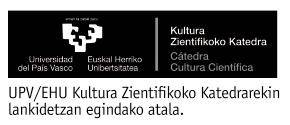“To socialize science it is important to work in one’s own language”
Many have known Naima El Bani Altuna through Twitter. Precisely to make known his experiences in the Arctic has used this social network, with the name of @arctic. It is not surprising, therefore, that there is a direct connection between El Bani and the Arctic. However, when El Bani himself was thinking of being a researcher, he had another place where he wanted to be a researcher, warmer and more welcoming than the Arctic.
However, even though he did not know exactly what, since he was a child he was clear that El Bani was going to devote himself to science: “Our mother is a biologist and as a child we did experiments in the kitchen. Since then I had clear that I was going to play science. Yes, I had no idea what he would be a geologist and would research in the Arctic.”
He confesses that he began studying Geology out of curiosity. And he was very surprised when he saw that it was not like what they told him in the beginning: “As they told us at first, it seemed like I was very oriented to oil and the world of fuels, and I didn’t want that. On the contrary, he was concerned about climate change and wanted to go in that sense. And I am happy, because I have found the opportunity to make the way I wanted.”
For this purpose, El Bani recognizes that the teachers of the UPV were key. What's more, he then visited France, Canada and Norway and realized that the UPV level is really good. “In addition, the teachers I had wanted to teach and that is appreciated a lot,” explains El Bani.
He also recalled that they made many exits, including Sopelana and Zumaia. “We learned to apply geology and in the master’s degree in France we did not have so many outputs. Once yes, we had a one-week start and went to the Basque coast! Then I was an advanced student,” he laughs.
To the Arctic by surprise
The first year of the master wanted to work with foraminifers in the Gulf of Bizkaia. In addition, his father is Moroccan and discovered that in Bordeaux there was a professor investigating in the Gulf of Bizkaia and the Atlantic coast of Morocco. Therefore, he addressed him to carry out the project. And he accepts. From there it did not happen as expected: “One group told me I needed help with foraminifers, who worked in the Arctic with Arctic foraminifers.” Thus he arrived in the Arctic.
It was an unexpected destination, but he recognizes that he loves it. “It has difficulties: special boats are needed to break the ice, it is cold… but it is very enriching. On the ships, depending on the objective of the expedition, we gather multidisciplinary researchers. My director makes paleoceanography and often leads biologists to understand the fossils of the past, because we need to know how living things work today. In addition, many times in the same expedition several projects are joined and we collaborate. Thanks to this, we deepened much more.”
Al Bani also considers enriching the coexistence in the ships. For example, he recalled the curiosity of the members of the Arctic expedition for the Basque language: “They didn’t know him and were surprised by the interaction he had on Twitter. It was totally romantic and they realize it has another status.”
The activity of Twitter has led him to win the Txiotesia prize organized by the UEU in the category of more intelligible txiola. He did not expect it at all, but he is happy because he is convinced that it is essential to socialize science. “And for this it is important to work in one’s own language. The researchers of my environment, be witnesses, speak English on Twitter, but my mother, for example, or some of my friends do not know English. If I want to understand what I am doing, I will have to tell you in Basque!”
Born in Bilbao in 1993. He studied Geology at UPV-EHU and subsequently completed his Master in Paleoceanography and Sedimentology at the University of Bordeaux. During the master's degree he had the opportunity to investigate the paleoceanography of the Canadian Arctic with foraminiferous and decided to continue his doctorate with the foraminifers of the Arctic, in the CAGE center, in the Department of Geosciences of the University of Tromsø, Tine L. Under the direction of Rasmussen and researchers Mohamed Ezat.



_article_big.JPG)



